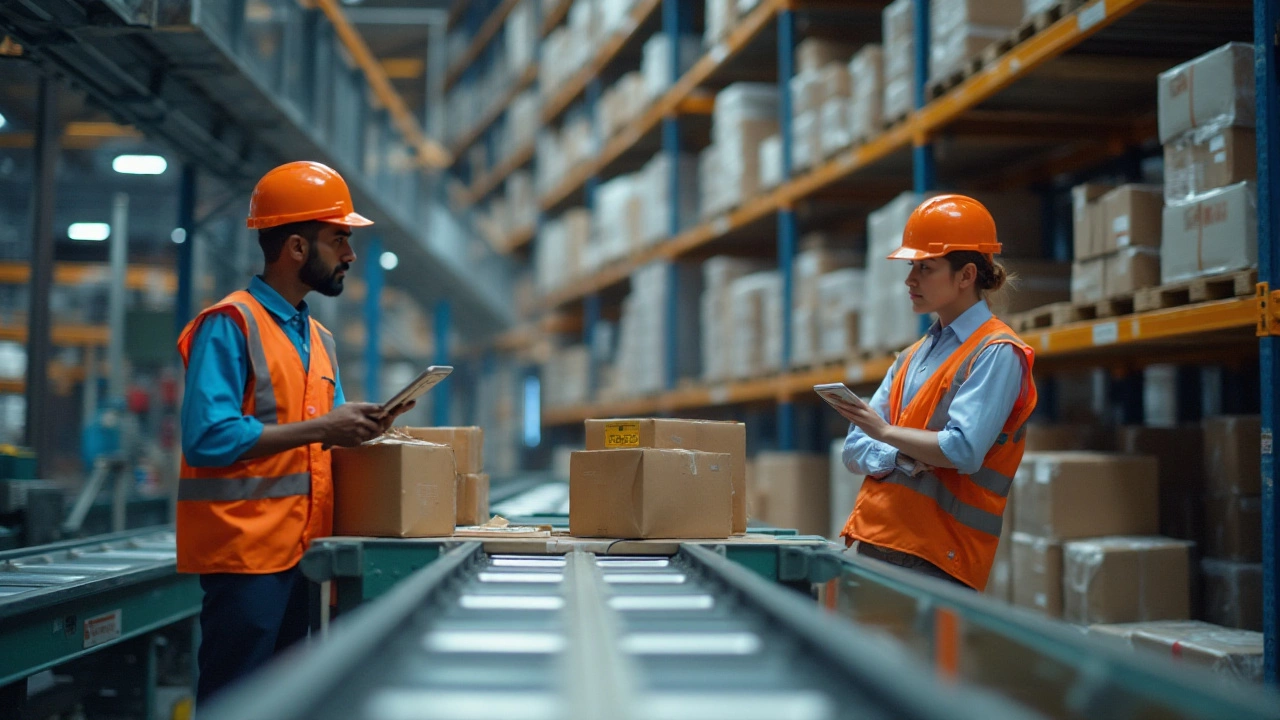The rapidly changing world of e-commerce brings with it the necessity to master logistics. For businesses looking to thrive, understanding the core rules of logistics can make the difference between soaring success and risky setbacks. Not only does effective logistics management ensure smooth operations, but it also plays a pivotal role in fulfilling customer expectations.
Delving into the realm of logistics, we will touch on the nitty-gritty of aligning your strategies with overarching business goals, ensuring that the flow of goods from one point to another is as seamless as possible. Whether you're just getting your feet wet or have been in the game for a while, these rules will aid you in refining processes and keeping costs in check.
Customer satisfaction sits at the heart of it all. Happy customers are likely to return, and efficient logistics can make or break their shopping experience. As you read further, consider how each rule can be tailored and fine-tuned to the specific needs of your business.
- Aligning Logistics with Business Goals
- Understanding the Importance of Inventory Management
- Enhancing Transportation Efficiency
- Leveraging Technology for Smarter Operations
- Building Strong Relationships with Suppliers
- Prioritizing Customer Satisfaction
Aligning Logistics with Business Goals
In today's ultra-competitive e-commerce landscape, aligning logistics with your overarching business goals is fundamentally important. It’s not just about delivering the product; it’s about ensuring every touchpoint in the supply chain reflects the values and mission of your company. The intimacy of e-commerce demands consistency, where logistics serve as a critical backbone that holds your company’s promises together. Developing a logistics strategy that works hand in hand with business objectives can greatly affect how effectively you can adapt and grow in the marketplace.
Understanding Business Vision and Values
When you start aligning logistics with business goals, the first step is a deep dive into your company's vision and core values. Reflect on what sets your brand apart and how logistics can support that differentiation. For example, if sustainability is at the heart of what you do, integrating eco-friendly practices in your e-commerce logistics not only aligns with these values but also promotes them. The integration can vary extensively depending on your objectives, whether it involves adopting greener packaging options or optimizing delivery routes to reduce the carbon footprint.
Synchronizing Objectives and Logistics Targets
It is crucial to translate business objectives into clear, actionable logistics targets. It involves identifying key performance metrics that measure the effectiveness of your logistics strategy within the scope of your overall business aims. Begin by asking what operational excellence means for your particular business. Is it about reducing delivery times by 20%? Enhancing customer satisfaction ratings? Efficient supply chain management becomes an ally in reaching these aspirations, pulling various facets of operations into synchronization, and creating a more cohesive outcome.
"Successful supply chain management isn’t just about efficiency, it’s about aligning every logistical decision with what the business stands for," says Dr. Melinda Crane, logistics expert and author.
A practical way to achieve these alignments is by implementing regular cross-departmental meetings or setting up collaborative platforms where logistics teams and business strategists come together. These interactions foster an environment where both logistics and business goals are clearly communicated, understood, and refined as necessary based on evolving market demands.
- Benefit 1: Aligning logistics with business goals allows for better allocation of resources, ensuring resources are used where they can provide the most impact.
- Benefit 2: It enhances the customer experience by ensuring that logistical operations reflect the brand's promise, fostering trust and reliability.
- Benefit 3: It provides a framework within which team members can innovate while still working towards unified goals.
In conclusion, viewing logistics as a fundamental part of the business strategy rather than a separate entity grants you the flexibility to respond effectively to changes and opportunities. It requires not just planning, but a detailed understanding and continuous communication with everyone involved. The key lies in crafting a logistics plan that is as dynamic as the rest of your business, one that doesn't merely serve the purpose but elevates it, making your entire operation more formidable and robust in the face of both challenges and opportunities in the e-commerce space.
Understanding the Importance of Inventory Management
Inventory management sits at the very core of the e-commerce logistics puzzle, serving as the linchpin that ensures smooth functioning from supplier to customer’s doorstep. Imagine a scenario where a booming online retail operation is inundated with orders, but their stock records are outdated. Items that show as available might actually be out of stock, leading to delayed shipments, disgruntled customers, and reputational harm. It's crucial to recognize inventory management's pivotal role in maintaining balance; with efficient processes, companies can reduce costs linked to excess or insufficient stock, while optimizing order fulfillment.
Understanding the flow and movement of goods in and out of your storage facilities demands careful coordination, and technology plays an essential part in this realm. Real-time inventory tracking systems and integration with sales channels provide transparency and accuracy that was decades ago hard to imagine. These tools help pinpoint which items are in demand, allowing for smarter purchasing decisions. Additionally, calculations for reorder points and safety stock levels can be fine-tuned through historic sales data, seasonal demand forecasting, and market trends.
An interesting tidbit can be learned from industry heavyweights such as Amazon, where sophisticated algorithms and automated warehousing systems keep track of a vast amount of merchandise. By learning how such systems work, businesses, large or small, can glean lessons valuable in shaping their own shipping strategies. Abe Eshkenazi, CEO of the Association for Supply Chain Management, aptly states:
"Inventory management is often viewed as mundane, when in reality, it is the epicenter of efficiency and customer satisfaction in supply chain management."This reveals an often ignored truth that logistics professionals must consistently navigate.
Practical Steps to Improve Inventory Management
Refining how inventory is managed could start with categorizing stock-keeping units (SKUs) based on their sales velocity, creating tiers to prioritize attention on high movers. By doing so, resources can be allocated to ensure these items are always in stock, which further connects to improved customer satisfaction. Techniques such as ABC analysis can support this segmentation process. Besides, a periodic audit not only verifies stock levels but also uncovers discrepancies that may influence business perceptions. Conducting these checks regularly reinstates control, allowing gaps to be addressed proactively instead of reactively.
Another effective method to optimize inventory is embracing a just-in-time approach, potentially lowering holding costs while synchronizing inventory procurement with actual demand. Although not without risks, it can be a strategic advantage when handled deftly. Equally essential is maintaining close communication with suppliers, ensuring there is a mutual understanding of expectations and lead times, thereby minimizing disruptions in the supply chain. This bond potentially expands into collaborative planning, forecasting, and replenishment frameworks, driving efficiency across the board.
In today’s dynamic market, inventory missteps can ripple through the entire supply chain, impacting finances and customer loyalty. Thus, emphasizing and investing in robust inventory management is a strategic necessity that reflects a business’s commitment to excellence in online retail. Integrate insightful analytics and sophisticated software to remain competitive and ensure logistics support the goals and aspirations of the broader business strategy.

Enhancing Transportation Efficiency
The heart of effective e-commerce logistics beats through the veins of transportation. This dynamic component ensures that goods journey swiftly from warehouses to consumer doorsteps. To excel in the e-commerce space, businesses must master the art of optimizing transportation efficiency. It's not just about minimizing costs, but also about improving speed, reliability, and adaptability to ever-changing market conditions. One fundamental method is to analyze and streamline current transportation routes, reducing excess mileage and consolidating shipments where feasible. Smart route planning often holds the key, saving both time and fuel—resources that every business values.
Innovation in transportation technology has proven indispensable. The use of GPS tracking and real-time data analytics enables businesses to monitor delivery trucks closely, allowing them to dynamically reroute vehicles in response to traffic conditions or other unforeseen disruptors. By adopting such technology, businesses can enhance their shipping strategies, ensuring that goods make swift, uninterrupted journeys. Moreover, investing in hybrid or eco-friendly vehicles could also aid in reducing carbon footprints, a growing consumer concern. Companies adopting these green practices not only protect the environment but also align themselves with customer values.
Building strategic partnerships with reliable logistics providers is another pivotal move. Collaborating with companies that have a strong distribution network can significantly bolster transportation efficiency for online retail operations. This collaboration allows businesses to tap into established systems, benefiting from their scale and expertise. According to McKinsey, 79% of consumers are more inclined to return if they receive a positive delivery experience.
“Transportation efficiency isn't solely about speed; it's about creating a seamless end-to-end journey for every product, aligning with the fast-paced demands of the modern consumer,” notes logistics expert Rebecca Hall from SupplyChain Magazine.
Technologies such as automation and Artificial Intelligence (AI) are increasingly impacting transportation efficiency. For instance, AI-powered software can predict and suggest optimal loadings and schedules, which ensures that trucks operate at ideal capacity levels. This leads to better resource allocation, reducing unnecessary trips and saving on costs. Automation in warehouses also contributes enormously by speeding up the packing and loading processes, which reduces the turnaround time for shipping. It is important, though, to balance technology with human oversight, ensuring that when technology fails, there are manual contingencies in place. Automation and human supervision, in tandem, create a resilient logistics operation.
Adopting a flexible approach in transportation strategies is paramount. Different e-commerce businesses have varied needs based on their target markets and product types. Tailoring transportation methods can enhance customer satisfaction—for some, it might be about offering same-day delivery options, while for others, emphasizing reliability and package tracking might take precedence. Flexibility enhances the ability to cater to diverse customer demands, sustaining competitive advantages. For instance, during peak seasons like the holiday rush, being able to ramp up transportation capacity quickly without losing service quality is a mark of excellence in logistics.
Integrating feedback mechanisms from customers can also drive continuous improvement in transportation strategies. By soliciting consumer insights post-delivery, businesses can identify pain points and areas of potential enhancement. This feedback loop not only serves to fine-tune existing operations but also fosters a customer-centric culture within the logistics framework. In an era where consumer behavior dictates market trends, aligning transportation strategies closely with customer expectations becomes crucial. The success of a business often lies in how adeptly it responds to the evolving needs of its customers, using those demands to guide logistics innovation.
Leveraging Technology for Smarter Operations
In the fast-paced realm of e-commerce logistics, technology stands as both a driver of innovation and a cornerstone of efficiency. It's astounding to witness how digital solutions reshape operations, streamline processes, and elevate the customer experience. From automation to artificial intelligence, the tech wave is stirring up the logistics landscape, offering tools that were unfathomable just a few decades ago. Businesses that fully embrace these advancements are not merely keeping up; they are surging ahead of their competition.
One revolutionary change has been the integration of IoT—Internet of Things—devices in logistics. These gadgets, equipped with sensors, offer real-time data that's invaluable for tracking inventory levels, monitoring the conditions of goods, and ensuring timely deliveries. RFID tags, a practical application of IoT, have become commonplace in warehouses and shipping containers, allowing businesses to minimize errors and losses significantly. By providing accurate data, these technologies empower companies to make informed decisions that can significantly boost their supply chain management efficiency.
Automation in Warehousing and Distribution
Automation technologies in warehousing are no longer the distant future; they are today's necessity. Automated storage and retrieval systems (ASRS) and robotic pickers are revolutionizing order fulfillment, reducing human error, and ramping up speed. It's incredible how swiftly machines can handle repetitive tasks, allowing human workers to focus on more strategic roles. For many companies, the initial investment in such technology pays off exponentially, as they witness greater accuracy and efficiency across their operations.
Utilizing Advanced Analytics and AI
Advanced analytics and artificial intelligence have also become game-changers in supply chain management. By crunching vast amounts of data, these tools provide insights that were once unimaginable. Predictive analytics can forecast demand with a high degree of accuracy, enabling businesses to maintain optimal inventory levels and minimize waste. AI-powered demand forecasting tools are invaluable, especially in retail sectors with fluctuating consumer demands. According to a McKinsey report, companies that effectively use AI-driven logistics can cut down delivery times by up to 40%, a significant advantage in a competitive market.
AI and machine learning algorithms can now identify patterns and predict future behaviors with remarkable accuracy, fundamentally transforming logistics operations.
The rise of chatbots and AI-driven customer service is also worth noting. These virtual assistants are available around the clock, providing customers with tracking information, answering queries, and handling complaints with efficiency that matches, and sometimes exceeds, that of human operators. With natural language processing improvements, these systems are becoming more intuitive and human-like, further enhancing the customer experience.
Cloud Computing and Real-Time Collaboration
Cloud-based platforms offer a haven for real-time collaboration. They ensure that everyone, from warehouse workers to executives, has up-to-date access to critical information. Such transparency is essential for making quick, informed decisions and responding promptly to any disruptions in the supply chain. Furthermore, cloud solutions facilitate seamless communication with suppliers and partners, fostering a collaborative environment that's integral to modern logistics practices.
While there's excitement about what technology can achieve, it's crucial to remain vigilant against the challenges. Concerns about data privacy and security must be addressed, ensuring that sensitive information isn't compromised. However, with the right measures, these hurdles can certainly be overcome. Embracing technology is no longer a luxury; it is a strategic mandate for anyone looking to sustain and grow their e-commerce ventures in today's digitally dominant marketplace.

Building Strong Relationships with Suppliers
In the complex world of e-commerce logistics, building strong partnerships with suppliers isn’t simply beneficial; it's imperative. Suppliers play a crucial role in the supply chain, acting as the backbone for your product availability and, consequently, your business's reputation. Developing a robust relationship with your suppliers can translate directly into operational efficiency, offering a seamless flow of goods and an enduring competitive edge in the market. The more trust you invest in those partnerships, the more responsive and accommodating your suppliers are likely to be, which is essential for adapting quickly to market changes or unexpected demands.
Communication is the cornerstone of any healthy relationship, and it's no different in business. Regular, open dialogue with suppliers ensures transparency and keeps both parties in the loop regarding important updates like demand forecasts, raw material availability, and production schedules. Consistent communication provides early warnings for potential supply chain disruptions, enabling proactive problem-solving before issues affect your bottom line. Additionally, fostering transparency can help your suppliers understand your business's specific needs better, leading to customized solutions and services that work in your favor. This bilateral flow of information fosters an ecosystem of trust and collaboration that contributes significantly to an effective supply chain strategy.
"At the heart of any successful business, there's a stable supplier relationship that can be pivoted to ensure a sustainable competitive advantage," remarks supply chain expert, Dr. Anna Norris.
Moreover, it’s essential to treat your suppliers as partners rather than mere vendors. This perspective shift encourages more engagement and fosters collaboration on improvements not only in product delivery but also in product development and innovation. Crafting this kind of synergistic relationship involves recognizing and addressing suppliers' concerns genuinely, which often align closely with your company's interests. Joint efforts such as development projects or testing new logistics innovations can mutually benefit you and the supplier, ultimately enhancing your supply chain management approach.
Another practical approach to reinforcing supplier relationships involves valuing their time and contributions. Acknowledging their support and showing appreciation can solidify these professional bonds. This appreciation often translates into better deals, priority service, and insights into industry trends that might not be readily available to other businesses who don't value their suppliers as much. Supplier relationship management is a critical facet of logistics that contributes as much to reducing overhead costs and improving business agility as technological advancements do. Therefore investing time and effort into nurturing these relationships is akin to investing them into the growth of your business itself.
Still, many businesses often overlook the power of collaborative agreements. Such agreements can lead to increased efficiency and reduced risks. A collaborative agreement can specify shared goals, agreement terms, and dispute resolution mechanisms, ensuring that both parties maintain a harmonious partnership that is beneficial in the long run. Engaging in regular performance reviews and joint strategic meetings will provide both parties with insight into performance metrics and areas for improvement, resulting in continuous improvement and optimized performance. Building these structured pathways helps in mitigating conflicts and aligning supplier's goals to yours, benefiting the entire logistics value chain.
In closing, fostering strong, purposeful vendor relationships is a dynamic process that requires a strategic blend of communication, collaboration, and trust-building. Prioritize these aspects in your supplier relationships to ensure your business remains resilient and your supply chain agile and responsive in the face of the modern-day challenges of online retail.
Prioritizing Customer Satisfaction
In the complex world of e-commerce logistics, keeping your customers satisfied should always be at the forefront of your priorities. When we talk about customer satisfaction, we aren't just referring to ensuring they receive their products on time; it's about creating an entire experience from the moment they click 'buy' to the time they unbox their purchase. Speed and reliability are the cornerstone of customer satisfaction in logistics. Interestingly, research shows that 85% of consumers are willing to pay more for a better experience. This statistic highlights the importance of providing not just what the customer expects, but exceeding those expectations to build loyalty and trust.
Providing accurate tracking information is a great way to keep customers informed and satisfied. As soon as an order is placed, customers should receive clear information on when they can expect their packages. Companies like Amazon have set high standards by offering real-time updates on the progress of deliveries. By investing in state-of-the-art technology that supports this kind of transparency, businesses can significantly enhance the customer's journey. A customer who knows exactly when their product will arrive is usually a happy customer.
Once the package arrives, the battle for satisfaction doesn't end. The presentation of the package itself can make a big difference. Offering eco-friendly packaging options, for instance, can add to a customer's satisfaction, knowing that their purchase hasn't come at a great cost to the environment. Considering that more and more customers are becoming eco-conscious, it may be beneficial for businesses to offer sustainable packaging options as a standard feature. Happy customers are likely to leave positive reviews and make repeat purchases, which is crucial for long-term success.
Handling returns and exchanges efficiently is another critical component of prioritizing customer satisfaction. A seamless return process can turn what might be a negative experience into a positive one. According to a 2022 survey, 67% of consumers check the return policy before purchasing. Having a clear, straightforward policy can potentially boost your sales. Make sure customers have an easy way to return products without jumping through hoops. Offering free returns or exchanges may result in short-term costs, but the loyalty gained can outweigh these expenses over time.
Creating a Customer-Centric Logistics Strategy
Crafting a logistics strategy that centers around the customer can significantly benefit your business. Every decision within the supply chain should take into account its impact on the end customer. Understanding customer behavior and preferences can guide your logistics practices. For instance, offering multiple delivery options can provide flexibility that caters to varying customer needs. While some customers may prefer expedited shipping, others might choose a slower, more cost-effective method. Thus, having diversified options can work wonders for customer satisfaction and retention.
"Customers remember the service a lot longer than they remember the price." - Lauren Freedman, President of the E-Tailing Group.
Training your customer service team to handle inquiries and complaints effectively is another essential component. Your team should be equipped with the knowledge and tools to resolve issues quickly. A friendly and efficient response can turn a potentially unhappy customer into a loyal advocate. Ensure your staff is knowledgeable about your logistics processes so they can offer the most precise information to customers, reducing frustrations and improving overall satisfaction. By making these strategic adjustments, your business can not only meet but exceed expectations, resulting in happy customers who will likely return.


